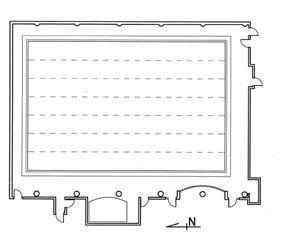
Down the Drain:
Energy Consumption at the Berkeley YMCA Pool
A Vital Signs Case Study
Prof. Alison Kwok/ARCH 507/University of Oregon Architecture Dept.
Methodology
Energy Smart Pools Info
Team Members:
Anne Deutsch
Ram Ganapathy
Geoff Grummon
Methodology
Upon reviewing some construction documents of the lap pool, we found no insulation around the foundation of the entire perimeter of the pool. Therefore, we initially believed that heat from the pool water was being lost to the surrounding concrete and earth. Because of the difficulty measuring the heat loss from conduction and convection, we measured the heat loss from evaporation and the total heat loss; the difference between these is the amount of heat lost from convection and conduction.
heat loss from evaporation + heat loss from conduction + heat loss from convection = total heat loss
Based on our initial assumptions, we determined this procedure to collect the required data to determine how energy was lost from the lap pool.
1. The first step was determining how much energy the existing pool water heater is using. We attached a "HOBO" datalogger to the heater's metal case to help us determine how often the heater was turning on and how long it stayed on. The HOBO measured the temperature of the metal case over a four-day period; when the case was around 110 °F, the heater was running, and when the case was at room temperature the heater was off. Specifications of the heater showed the amount of energy consumption per hour; the amount of energy the heater put into the pool is the same as the heat lost from the pool because the temperature is maintained at 82 °F. Current natural gas prices for the local utility company, Pacific Gas and Electric, were found to allow us to find out roughly how much the YMCA is spending on heating the lap pool.


2. We determined how much heat is lost to evaporation. We measured the physical dimensions of the pool and the volume of water it holds. The temperature of the water, the temperature of the air, and the relative humidity were measured over a four-day period using HOBOs. From this information we were able to determine the amount of evaporation and subsequent heat loss from the pool. The difference between the total heat loss and the heat loss from evaporation is the amount of heat lost through conduction and convection.
3. Then we measured the physical dimensions of the roof and noted the skylight locations. Data was collected at four different reference points by using a ‘solar transit’ device that locates any obstructions on the horizon that may interfere with the amount of available sunlight at different times of the day and different times of the year. Climatic data for Berkeley, California was gathered to determine the amount of available sunlight.
4. Finally, we examined possible solutions for reducing energy consumption based on the collected data. Solar hot water systems and pool covers were investigated. A computer program, "Energy Smart Pools," from the US Department of Energy was used to estimate potential energy savings. An in-depth summary of the how the program estimates energy savings and the assumptions it makes can be found by clicking here.

Using the Solar Transit